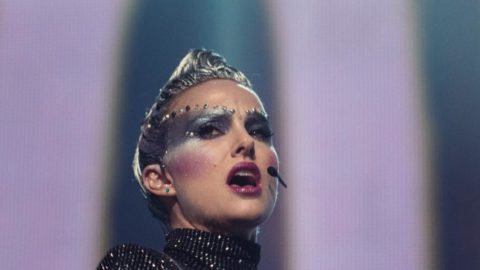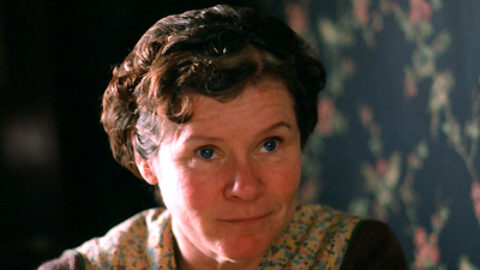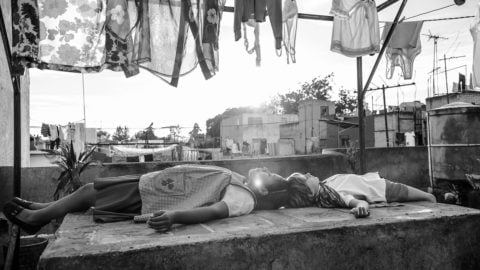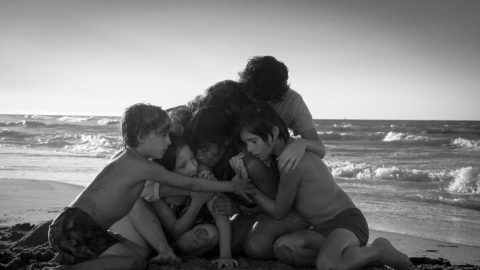Venice Interview: Mike Leigh

Three-and-a-half years in the making, and just about two centuries after the events it portrays, Mike Leigh’s Peterloo had its world premiere at the Venice Film Festival. Leigh’s ensemble historical drama of the 1819 Peterloo massacre and its run-up is a radically structured story of the political process in action, on the ground. In an industrializing Manchester, the 98 percent who cannot vote, spanning classes, find common cause, but most of the 154-minute film consists of the rallying to action and the brutal governmental intrigues that precede the peaceably gathered, violently quashed protest. Leigh circles among a working-class family, a panel of vicious magistrates, callous aristocrats and parliamentarians, and assorted radicals and politicos marshaling the era’s rhetoric to persuade and explicate. Hopes are high—and Leigh’s treatment of the protest’s wrenching aftermath devastatingly concise. I spoke with the filmmaker (who had praised Amazon as “immaculate” in their collaboration) shortly before the gala premiere of Peterloo.
One of the challenges of making this film must have been staging the crowd scenes. What was your strategy for shooting the protest sequence?
Obviously it took a lot of planning. There are established and conventional movie ways of doing those kinds of things, and how I work, irrespective of content, is to create the action and then to work out how to shoot it by being there. I don’t ever use a storyboard artist or any of those things. It’s about being there and actually looking at stuff and deciding how to shoot it in an organic way. I was very insistent that we should approach that sequence in precisely the same spirit, giving me the same freedom to explore, with the cinematographer Dick Pope.
And where was “there,” what space were you in?
In reality it’s called Tilbury Fort. It’s at Tilbury Docks down in south of England. It’s famously where immigrants arrived. About an hour out of London. The fort was built by Henry VIII originally to keep out the Catholics, and then it was extended by Charles II. Quite an ancient monument. It’s basically a huge military parade ground, about the right size historically. It has nothing to do with the history of the film—the event took place in the middle of Manchester [but] they built a great Victorian city after 1890, so ironically not one frame of the film was shot in Manchester. It was shot in various other places around the country.
Part of the answer to the question is all the elements in the sequence—the magistrates in the house, which was actually there [on the square], the people on the hustings, the family [in the crowd]. The big stuff we shot with three camera crews so that we could get stuff. The key objective was it shouldn’t be bog-standard wall-to-wall—people have said, ah yes, battle scenes, battle scenes. It’s not a battle scene! With battle scenes, you have faction A and faction B who are in a condition of equal confrontation. This was chaos. This was a mess that happened in 1819, and we had to get all that on the go. And the guys that played the yeoman and the military really knew what they were doing character-wise. I use improvisation a great deal in my films, although mostly you never see improvisation on screen, it’s by way of preparing. Nonetheless, [here] you have to liberate that stuff so that this was living and not merely looking like pretending.
The reason I ask about the crowd scenes is because so much of what the film captures is process—the democratic process on the ground.
One of the key elements thematically, dramatically, narratively, and historically in the whole event is what was going on in the room with the magistrates. That is more or less in broad terms the dramatization of what they did. Some of them are drawn from actual people, and others were invented, but the internal politics and dynamics of what’s happening with those guys is important. And that obviously had to be structured in relation to the various elements.
The magistrates are supposed to be officials, but they come across as a miniature version of mob rule.
Totally, and the power they had was absolute. And the home office had this secretary, and [Manchester] was a distant place where a lot of seditious nonsense was happening that needed to be dealt with, and contained. They never went there and understood what people’s lives were about or any of that stuff. It has political resonances all down the line. Those magistrates, a lot of them are clergy, so they’re not only magistrates but if they weren’t doling out to the magistrates’ court, they were in a pulpit. These are people that obviously like to be heard. And the church had a massive grip on everything.
The power they wield in the cases they judge is frightening. You set the tone for the inequality of the time with the montage where each magistrate hands down this severe, seemingly arbitrary sentence.
Those are real cases by the way. Those were actually tried by those guys.
It reminded me of—you’ve probably seen those films by Frederick Wiseman, in court.
Oh yeah, totally.
What I keep returning to is the power of language—not just these magistrates passing judgments, but the way that the political speeches show democracy in action at that time. You really want to show the work of it all. What went into planning the film’s speeches and how they progress with the movement?
The problem of the film that presented itself was, how do you explain the politics, in a digestible form, in the movie? And once having passed the paranoia line of “Won’t long speeches in a film be boring?” I actually thought, okay, [we can do it]. As long as the speeches are compelling, and we understand what they’re talking about, and they are organic, and they are in character and all the rest. We were very strict about how we took original material, edited it, made it work for character, avoided all the repetitions, and so on. Once you bite the bullet you say, well, you know, you either tell this story or you don’t. What you can’t do, which I don’t think you ever should do anyway, is to regard the audience as being of inferior intelligence. I always work on the assumption that the audience is at least as intelligent as I am, if not more so.
And of course the audience is not confronted by a bland abstraction called speech—they’re characters saying things. Then what starts to be interesting, what I think is at the center of the thing to a great degree, is the fact that there are these different levels. The hothead radicals, young guys, who were in fact just banged up and pulled out of the way. Then there were the middle-class, reasonable radicals. Then of course you’ve got a self-publicist like Hunt.
He’s a celebrity.
Totally. I mean, he embraced the cause, he took all the opportunities to do what he says—which is to address large groups of people. He was passionately in love with himself, and as arrogant as they come. He was immensely popular, and is chillingly familiar.
Yes, he happens to be saying the right words, but what if he wasn’t.
Well, yeah! Absolutely.
At a certain point perhaps, a demagogue is a demagogue.
Yeah.
I like how the film comes back to the audiences at these speeches. Sometimes people are getting into it, sometimes not, and they’re quite vocal.
Language itself has always been fascinating for me in all of my films, whether you’re talking about ordinary, as it were, proletarian language or any other sort of language. And this film, not only have we gone to town with the language of politics, but there’s class language—there’s regional working-class period dialect. I have no hesitation to incorporate obscure words that have long since disappeared from the language.
Yeah, what are they saying when they say goodbye?
“Seethee.” Which means “see you”—“see thee.” See thee in the morning. Or I will see thee another time.
I might have to use that, that’s got a nice ring to it.
[Laughs] Well, you can, it’s slightly eccentric, but that’s up to you.
The way the Prince Regent speaks, does that perhaps tend a bit toward—
Caricature?
Or just accentuating the grotesque, as he’s sitting there in utter comfort.
Some journalist said, oh, I didn’t like the fact that he was treated as a pantomime character. Well, he isn’t. First of all, he’s wearing makeup because he did. Those aristocracy did. The visual reference for how we show him in the last scene with his mistress, Lady Conningham, comes directly from the famous caricatures of Gillray and Rowlandson of the time, that were very popular. How they’re behaving is pretty feasible. It’s outrageous, but some people are, in a word.
The most damning portrait is the accurate one, sometimes.
Yeah. But it is very serious obviously—the disgusting way that the massacre is dealt with and immediately sanitized.
One of the characters we follow throughout is the mother [Maxine Peake] in a working-class family. And I can’t get her tragic trajectory out of my head. She begins as a skeptic of the protests, because why shouldn’t she, it seems so unlikely. Then you see her at the protest, where she shows a natural generosity with her neighbors. But by the end, the worst does happen, and you can imagine her thinking, why did I do this? She’s lost a son [David Moorst] who had just barely survived a war. It’s a terribly hard point to end on.
Yeah, that’s what it’s about. And quite a lot of veterans of Waterloo were at Peterloo. There was at least one such guy who actually died, two weeks after getting his injuries. So I borrowed from that for that character.
There’s almost a resonance with the Vietnam War, you know, veterans coming back. You went to the Grosvenor Square protests against the war—did any of that kind of come to mind?
Yeah, of course.
The years around 1819 are such an extraordinarily eventful period. This is 1819, so we’re only about 30 and 40 years out from the French Revolution and the American Revolution respectively.
Oh, yeah, the French Revolution, not least, sat in their recent memory. That is what motivated the authorities, and the royal family were terrified. They were scared shitless that it was going to happen, no question. It’s very, very recent from 1819.
And you have this poignant scene where Maxine Peake’s character is musing to her husband just before going to sleep: what’s it going to be like for her grandchild when she lives to the year 1900. How do you view that scene? It’s also a tough one because, well, by 1900, you get the two World Wars right around the corner.
That’s right. I suppose what’s interesting on a personal level about that scene, is that we shot it about a week before my first grandson was born. So he was very imminent. I was very much thinking about what the world’s going to be like—and I still am, he’s 1 now—at the next turn of the century. So I thought, well, actually that does resonate with this, so that’s why I put that in. It’s easy to forget the future. The thing about the Peterloo Massacre, historically, is that it happened less than a century before my parents were born. They were born in 1914 and 1916, respectively. Apart from the thoughts I’d been having about my impending grandson, I felt the need to link it with our sense of now in some way. Once you say “1900,” then we can relate to all that.

Thinking about the sense of now and the future, that brings me to the scenes in the countryside, where they’re practicing their marches. They have this bucolic or even utopian quality, something heightened and almost dreamy.
Yes, I think that’s right. You’re talking about an agricultural, a rural world then, which is the same rural world of the 18th, 17th, 16th centuries. It’s an unchanging, unspoiled world, through which we have now built motorways, and built modern awful towns where people are on drugs etc., etc. As contrasted with the horrible industrial big centers like Manchester just down the road. There’s this innocence and optimism of the people—all we have to do is express what we want, what are our rights, and people will listen to us, they have to listen to us, it’s only natural. So yes, it is an expression of a kind of rural idyll, without it being either sentimental or irresponsibly romantic. You know, they’re marching up and down in the middle of nowhere. What the film doesn’t show, because it was beyond our means, was the scale of people pouring into towns everywhere. We imply that, but you don’t actually see it.
Among these various storylines, I was curious to see more about spy activity undertaken against the protest organizers. Did you shoot more of the spy material, or any of that?
No. I mean, it’s good that you wanted to see more. It would have been not so good if you wanted to see less. [Laughs] You’re cramming in a massive amount of stuff into two-and-a-half hours, which is longer than anyone wanted it to be, you know. You could make a whole film about the spy network: it’s massive, the crookedness involved was fantastic, and the amount of money that changed hands. But I’ve distilled it down into one-and-a-half studies of spies. You get just enough to get the flavor of it, the duplicitousness of it.
Going back to those countryside marches, you’re using drone shots, right? Have you used those before?
No, it’s the first time.
What did you think of it?
It’s great. You can do all that with simplicity and control, cheaper, and they’re very good guys that do it. A very good team shows up and they do what you want, and we used it sparingly, we’d have them for a couple of days. But there are far more remarkable new technical things in this film than that—that’s simply an obvious device that flies the camera up and down. Far more exotic and esoteric is the fact that we had 200 crowd artists and crowd replication gives you the massive number that there are. Not only that, but as I’ve already said, we shot it at this rather windswept, desolate place called Tilbury Fort, but all around are all these Manchester factories and churches, and things, all of which were put in by CGI afterward, brilliantly, and we worked very closely with these guys, and were very relentless with making sure everything was impeccable.
Does working with CGI feel a bit like painting? Because you have a crowd scene, and there’s aspects of balance, and color, and distribution of figures.
Yeah, it’s very much like that. We did it on Mr. Turner when they see the Fighting Temeraire, that ship. I was very cautious—I said, if it doesn’t work, we’ll cut the scene. LipSync was [the CGI company]. In the time between the two movies they’ve obviously done all kinds of stuff on big movies, and they’ve just got better. I don’t really know how you could possibly have made that film without this technology. And our historian Jacqueline Riding, an art historian who was my historian on Mr. Turner, for every scene where there were crowd artists, she would explain to them in absolute detail who they were, and why they were, and what their feelings were and what the objectives were. So you do get crowd artists who actually look like they know what they’re taking part in and they’re not just lumps of wood, pieces of meat.
With the protest sequence in Peterloo, I like how you get the sense of people jostling for the stage, on the hustings.
There are some very famous engravings of that event, so one of the joys is simply to get it looking like the famous images of it, and breathing life into them, and making other people talk.
When you were reading the public addresses of the time, what struck you most?
One of the things that’s really interesting and important to me is this: they didn’t have the vote, 98 percent of the population, they didn’t have education, and yet you get these working-class lugs standing up, making these long speeches, quoting the classics.
Yeah, they’re referencing the Bacchae.
Yeah! Because they were hungry for education, they were hungry for democracy and education, and they learnt, and they taught themselves, and the Sunday schools were important. At one point they actually talk about “Sunday school orators.” So apart from anything else about reading those speeches, what’s interesting and important is the articulacy and the literacy. One of the tragedies of England, particularly now, is that people have the vote and they don’t vote. They have education and they don’t respect it. But that’s a whole different thing…
Thinking about Peterloo in the larger context of your work, I was connecting a bit with two prior films primarily. In Vera Drake, you have someone who’s very dedicated to a particular ideal of access, despite its being outside the law, and then I thought actually a bit about something like Happy-Go-Lucky, where you have a woman with an ethos of positivity and resilience, which also seems relevant. In some sense perhaps this movie brings together a couple of strands in your work.
Yes, I think that’s right. It’s quite hard for me to articulate all of that, but it is an underlying theme, which is to say it’s an underlying obsession, an underlying aspiration or concern. One could probably find resonances of what we are now talking about in all of my films. Whether you’re talking about the frustrated idealists at the center of High Hopes, or even in Mean Time—Mark, the intelligent brother, is at some level an antecedent of the radicals. He wants to break out, and he’s constantly asking questions, and has ideals.
And of course you can’t have this conversation without bringing in my antihero of Naked. I always think that Johnny in Naked and Poppy [in Happy-Go-Lucky] are flipsides of a coin. They’re both idealists. They’re both questioning. But whereas he is a frustrated idealist, simply pissed off and disappointed with the world, and it’s turned in on itself, she’s the opposite: she’s an idealist who actually does it, puts her money where her mouth is, and deals with stuff. And when the shit hits the fan with her, with this lunatic rape, she actually deals with it, and she knows how to deal with it. She knows how to deal with kids and she knows how to deal with him—all that. But it is motivated again by the same sense of justice. And there you go.
Nicolas Rapold is Film Comment’s editor-in-chief.







